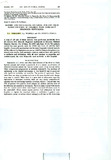| dc.contributor.author | Odhiambo, F.A | |
| dc.contributor.author | Wamola, I.A | |
| dc.contributor.author | Ndinya-Achola, JO | |
| dc.date.accessioned | 2013-02-28T05:39:44Z | |
| dc.date.issued | 1991 | |
| dc.identifier.citation | East African Medical Journal Vol. 68 No. 10 November 1991 | en |
| dc.identifier.uri | http://erepository.uonbi.ac.ke:8080/xmlui/handle/123456789/12177 | |
| dc.description.abstract | A total of 120 sets of blood cultures were performed aerobically from 60 children with clinically diagnosed septicaemia at Kenyatta National Hospital, Nairobi. Out of these, 36 (30%) sets from 19 (31.7%) patients yielded bacterial growth while 84 (70%) sets from 41 (68.3%) were negative. Salmonella typhimurium was the most frequently isolated bacteria (63%), followed by SlIlphylococcus aureus (15.8%). Salmonella typhimurium isolates were mostly multi-antibiotic resistant, most of them only sensitive to amlkacln and cefotaxime, while all were resistant to ampicillin and co-trimoxazole, the most frequently used antibiotic in this hospital. | en |
| dc.language.iso | en | en |
| dc.title | Aerobic and facultative bacterial isolates from blood cultures of children with clinically diagnosed septicaemia | en |
| dc.type | Article | en |
| local.embargo.terms | 6 months | en |
| local.publisher | Department of Medical Microbiology, College of Health Science University of Nairobi | en |

